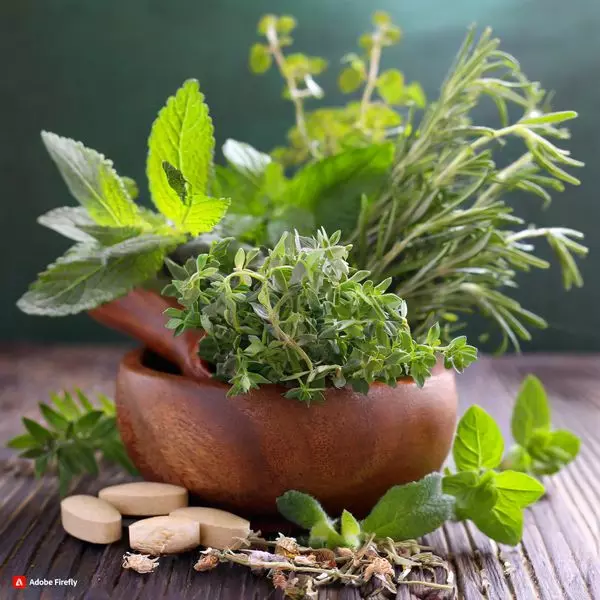In a world where the quest for optimal health is paramount, the answer might just be hiding in plain sight – your spice rack. As our diets evolve, the importance of understanding the medicinal powers within our culinary herbs becomes increasingly clear. The seemingly ordinary oregano or basil in your spaghetti sauce may hold the key to transforming your kitchen into a pharmacy of ancient healing wonders.
Kitchen Herbs: A Historical Perspective:
Certified Herbalist, Kelly M. Shattuck, based in North Carolina, sheds light on the historical significance of culinary herbs. Before the era of health food stores, these herbs played a vital pharmaceutical role in households. Shattuck emphasizes the accessibility and affordability of kitchen herbs, making the process less intimidating for individuals. According to her, tapping into the healing potential of these herbs is as simple as reading, utilizing what’s on your spice rack, and putting that knowledge into practice.
Brewing Herbal Teas:
To harness the benefits of culinary herbs, Shattuck provides insights into preparation methods, particularly the brewing of herbal teas. Whether making an infusion for delicate herb parts or a decoction for tougher materials, the process involves a careful balance of temperature and time. Straying from the conventional tea ball method, Shattuck suggests placing loose herbs directly into the water for a more thorough release of properties.
Exploring the Medicine Cabinet:
Delving into the specifics of some key culinary herbs, we uncover their dual roles as both flavor enhancers and medicinal treasures.
Basil (Ocimum basilicum):
Beyond its culinary prowess, basil serves as a stress-reliever and mood enhancer. Shattuck recommends infusing minced basil leaves for a calming bedtime tea.
Bay leaves (Laurus nobilis):
Aside from enhancing the aroma of dishes, bay leaves offer benefits for the stomach and intestinal tract. Shattuck suggests adding extra bay leaves to soups or brewing a tea to calm the digestive system.
Black pepper (Piper nigrum):
Known for its stimulating properties in Chinese medicine, black pepper aids circulation. Shattuck recommends a decoction for poor circulation or low energy levels.
Cayenne (Capsicum annuum):
Described as the most potent stimulant in your spice rack, cayenne’s hemostatic and astringent qualities make it versatile. From stopping bleeding to aiding digestion, cayenne proves to be a remarkable heart tonic.
Cinnamon (Cinnamomum verum):
Beyond its sweet aroma, cinnamon aids digestion and is being explored for its potential in controlling blood sugar. Shattuck suggests combining it with other herbs to make teas more palatable.
Cloves (Syzygium aromaticum):
A prized spice in ancient trade, cloves showcase analgesic and germicidal properties. Applied topically, clove oil can alleviate toothache and reduce fever.
Fennel (Foeniculum vulgare):
With carminative properties, fennel aids digestion and relieves gas. Fennel seeds, whether infused or sprinkled on food, prove effective in various scenarios, from colds to lactation support.
Sage (Salvia officinalis):
Found in European dishes, sage serves as an astringent and antibiotic. Its tea offers relief for winter coughs, and it’s known for its cleansing properties.
Garlic (Allium sativum):
A versatile herb, garlic’s antibacterial and immune-boosting properties make it a go-to for colds and flu. Shattuck shares a cold-fighting concoction involving garlic, honey, and tamari or soy sauce.
Ginger (Zingiber officinale):
Beyond its culinary uses, ginger is praised for relieving nausea, boosting circulation, and combating arthritic inflammation. It’s a staple remedy for motion sickness and colds.
Nutmeg (Myristica fragrans):
Used sparingly, nutmeg aids in settling the stomach, making it useful in cases of food poisoning. Shattuck recommends it for reintroducing solids after illness.
Oregano (Origanum vulgare):
Known for its robust flavor, oregano strengthens the immune system, aids digestion, and possesses antioxidant properties. Its infused tea promotes restful sleep.
Peppermint (Mentha × piperita):
With calming properties, peppermint soothes the digestive system. Peppermint oil capsules are recommended for those with intestinal issues, and studies show its effectiveness in relieving symptoms of irritable bowel syndrome.
Rosemary (Rosmarinus officinalis):
High in iron, calcium, and Vitamin B6, rosemary enhances mental retention. Aromatherapy with rosemary can relieve headaches and combat depression.
Thyme (Thymus vulgaris):
Used by ancient Egyptians, thyme’s expectorant and antiseptic properties make it ideal for throat issues and respiratory infections. Its antibiotic properties contribute to its role in first aid.
As we savor the flavors of our daily meals, let’s not overlook the potential healing powers within our spice racks. Culinary herbs, once revered for both taste and medicinal value, are making a resurgence in modern kitchens. Understanding the dual roles of these herbs allows us to embrace a holistic approach to well-being, turning our kitchens into pharmacies of ancient wisdom. So, the next time you sprinkle a pinch of oregano or stir in some ginger, remember – you’re not just enhancing flavor; you’re unlocking the medicinal marvels of your kitchen pharmacy.
Also Read: Astronomical Breakthrough: Physicists Identify Second-Most Powerful Cosmic Ray Beyond The Milky Way











